 W
WThe ampulla of ductus deferens is an enlargement of the ductus deferens at the fundus of the bladder which acts as a reservoir for sperm. This structure is seen in some mammalian and squamate species and is sometimes tortuous in shape.
 W
WThe appendix testis is a vestigial remnant of the Müllerian duct, present on the upper pole of the testis and attached to the tunica vaginalis. It is present about 90% of the time.
 W
WThe appendix of the epididymis is a small stalked appendage on the head of the epididymis. It is usually regarded as a detached efferent duct.
 W
WThe body of the penis extends from the root to the ends of the corpora cavernosa penis, and in it these corpora cavernosa are intimately bound to one another with a dorsally fenestrated septum which becomes a complete one before penile crura.
 W
WBuck's fascia is a layer of deep fascia covering the three erectile bodies of the penis.
 W
WJust before each crus of the penis meets its fellow, it presents a slight enlargement, which Georg Ludwig Kobelt named the bulb of the corpus cavernosum penis. The bulb of penis is also known as the urethral bulb.
 W
WThe bulbourethral gland or Cowper's gland is one of two small exocrine glands in the reproductive system of many male mammals. They are homologous to Bartholin's glands in females. The bulbouretheral glands are responsible for producing a pre-ejaculate fluid called Cowper's Fluid, which is secreted during sexual arousal, neutralizing the acidity of the urethra in preparation for the passage of sperm cells.
 W
WChyloderma is swelling of the scrotum resulting from chronic lymphatic obstruction. Obstruction may be caused by a nematode such as Wuchereria bancrofti. This condition is also known as lymphscrotum or elephantiasis scroti.
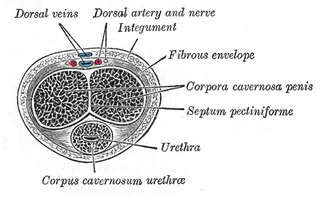 W
WA corpus cavernosum penis (singular) is one of a pair of sponge-like regions of erectile tissue, which contain most of the blood in the penis during an erection.
 W
WThe corpus spongiosum is the mass of spongy tissue surrounding the male urethra within the penis. It is also called the corpus cavernosum urethrae in older texts.
 W
WFor their anterior three-fourths the corpora cavernosa penis lie in intimate apposition with one another, but behind they diverge in the form of two tapering processes, known as the crura, which are firmly connected to the ischial rami.
 W
WEjaculation is the discharge of semen from the male reproductory tract as a result of an orgasm. It is the final stage and natural objective of male sexual stimulation, and an essential component of natural conception. In rare cases, ejaculation occurs because of prostatic disease. Ejaculation may also occur spontaneously during sleep. Anejaculation is the condition of being unable to ejaculate. Ejaculation is usually very pleasurable for men; dysejaculation is an ejaculation that is painful or uncomfortable. Retrograde ejaculation is the condition where semen travels backwards into the bladder rather than out the urethra.
 W
WThe ejaculatory ducts are paired structures in male anatomy. Each ejaculatory duct is formed by the union of the vas deferens with the duct of the seminal vesicle. They pass through the prostate, and open into the urethra at the seminal colliculus. During ejaculation, semen passes through the prostate gland, enters the urethra and exits the body via the urinary meatus.
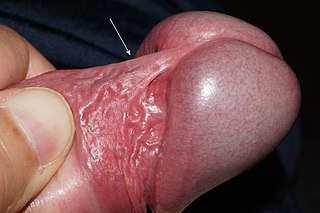 W
WThe frenulum of prepuce of penis, often known simply as the frenulum, is a highly erogenous elastic band of tissue under the glans penis that connects the foreskin to the vernal mucosa, and helps contract the foreskin over the glans. Along with the ridged bands at the tip of the foreskin, it is considered to be the most sensitive part of the penis to fine-touch.
 W
WThe fundiform ligament or fundiform ligament of the penis is a specialization or thickening of the superficial (Scarpa's) fascia extending from the linea alba of the lower abdominal wall.
 W
WThe germinal epithelium is the epithelial layer of the seminiferous tubules of the testicles. It is also known as the wall of the seminiferous tubules. The cells in the epithelium are connected via tight junctions.
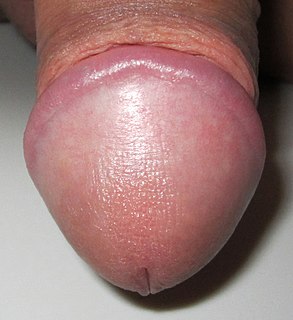 W
WThe glans penis, more commonly referred to as the glans, is a structure at the distal end of the penis in male mammals. It is the sensitive bulbous structure at the end of the human penis, and is anatomically homologous to the clitoral glans of the human female. The glans penis may be smooth, spiny, elongated, or divided in other mammals.
 W
WThe Icelandic Phallological Museum, located in Reykjavík, Iceland, houses the world's largest display of penises and penile parts. As of early 2020 the museum moved to a new location in Hafnartorg, three times the size of the previous one, and the collection holds well over 300 penises from more than 100 species of mammal. Also the museum holds 22 penises from creatures and peoples of Icelandic folklore.
 W
WThe glandular structure of the testis consists of numerous lobules.
 W
WThe mediastinum testis is a network of fibrous connective tissue that extends from the top to near the bottom of each testis. It is wider above than below.
 W
WMany mammalian species have developed keratinized penile spines along the glans and/or shaft, which may be involved in sexual selection. These spines have been described as being simple, single-pointed structures (macaques) or complex with two or three points per spine (strepsirrhines). Penile spine morphology may be related to mating system.
 W
WThe prostate is an accessory gland of the male reproductive system found only in some mammals. It differs between species anatomically, chemically, and physiologically. Anatomically, the prostate is found below the bladder, with the urethra passing through it. It is described in gross anatomy as consisting of lobes, and in microanatomy by zone. It is surrounded by a fibromuscular capsule and contains glandular tissue as well as connective tissue.
 W
WThe root of the penis is triradiate in form, consisting of the diverging crura, one on either side, and the median urethral bulb.
 W
WThe scrotum is an anatomical male reproductive structure located caudal to the penis that consists of a suspended dual-chambered sack of skin and smooth muscle. It is present in most terrestrial male mammals. The scrotum contains the external spermatic fascia, testes, epididymis, and ductus deferens. It is a distention of the perineum and carries some abdominal tissues into its cavity including the testicular artery, testicular vein, and pampiniform plexus. The perineal raphe is a small, vertical, slightly raised ridge of scrotal skin under which is found the scrotal septum. It appears as a thin longitudinal line that runs front to back over the entire scrotum. In humans and some other mammals the scrotum becomes covered with pubic hair at puberty. The scrotum will usually tighten during penile erection and when exposed to cold temperature. One testis is typically lower than the other to avoid compression in the event of impact.
 W
WThe seminal colliculus, or verumontanum, of the prostatic urethra is a landmark distal to the entrance of the ejaculatory ducts. Verumontanum is translated from Latin to mean 'mountain ridge', a reference to the distinctive median elevation of urothelium that characterizes the landmark on magnified views. Embryologically, it is derived from the uterovaginal primordium. The landmark is important in classification of several urethral developmental disorders. The margins of seminal colliculus are the following:the orifices of the prostatic utricle the slit-like openings of the ejaculatory ducts. the openings of the prostatic ducts
 W
WThe seminal vesicles, are a pair of two coiled tubular glands that lie behind the urinary bladder of some male mammals. They secrete fluid that partly composes the semen.
 W
WEach lobule of the testis is contained in one of the intervals between the fibrous septa which extend between the mediastinum testis and the tunica albuginea, and consists of from one to three, or more, minute convoluted tubes, the tubuli seminiferi.
 W
WThe corpora cavernosa penis are surrounded by a strong fibrous envelope consisting of superficial and deep fibers. The superficial fibers are longitudinal in direction, and form a single tube which encloses both corpora; the deep fibers are arranged circularly around each corpus, and form by their junction in the median plane the septum of the penis.
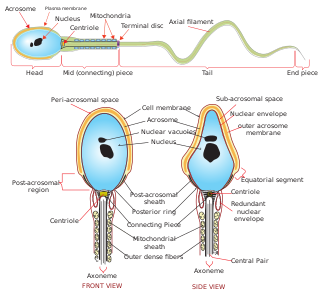 W
WSperm is the male reproductive cell, or gamete, in anisogamous forms of sexual reproduction. Animals produce motile sperm with a tail known as a flagellum, which are known as spermatozoa, while some red algae and fungi produce non-motile sperm cells, known as spermatia. Flowering plants contain non-motile sperm inside pollen, while some more basal plants like ferns and some gymnosperms have motile sperm.
 W
WThe spermatic cord is the cord-like structure in males formed by the vas deferens and surrounding tissue that runs from the deep inguinal ring down to each testicle. Its serosal covering, the tunica vaginalis, is an extension of the peritoneum that passes through the transversalis fascia. Each testicle develops in the lower thoracic and upper lumbar region and migrates into the scrotum during its descent it carries along with it vas deferens, its vessels, nerves etc. There is one on each side.
 W
WSpermatidogenesis is the creation of spermatids from secondary spermatocytes during spermatogenesis.
 W
WSpermatocytes are a type of male gametocyte in animals. They derive from immature germ cells called spermatogonia. They are found in the testis, in a structure known as the seminiferous tubules. There are two types of spermatocytes, primary and secondary spermatocytes. Primary and secondary spermatocytes are formed through the process of spermatocytogenesis.
 W
WSpermatocytogenesis is the male form of gametocytogenesis and involves stem cells dividing to replace themselves and to produce a population of cells destined to become mature sperm.
 W
WSpermatogenesis is the process by which haploid spermatozoa develop from germ cells in the seminiferous tubules of the testis. This process starts with the mitotic division of the stem cells located close to the basement membrane of the tubules. These cells are called spermatogonial stem cells. The mitotic division of these produces two types of cells. Type A cells replenish the stem cells, and type B cells differentiate into primary spermatocytes. The primary spermatocyte divides meiotically into two secondary spermatocytes; each secondary spermatocyte divides into two equal haploid spermatids by Meiosis II. The spermatids are transformed into spermatozoa (sperm) by the process of spermiogenesis. These develop into mature spermatozoa, also known as sperm cells. Thus, the primary spermatocyte gives rise to two cells, the secondary spermatocytes, and the two secondary spermatocytes by their subdivision produce four spermatozoa and four haploid cells.
 W
WSpermiogenesis is the final stage of spermatogenesis, which sees the maturation of spermatids into mature spermatozoa. The spermatid is a more or less circular cell containing a nucleus, Golgi apparatus, centriole and mitochondria. All these components take part in forming the spermatozoon.
 W
WThe subcutaneous tissue of penis is continuous above with the fascia of Scarpa, and below with the dartos tunic of the scrotum and the fascia of Colles.
 W
WIn males, the suspensory ligament of the penis is attached to the pubic symphysis, which holds the penis close to the pubic bone and supports it when erect.
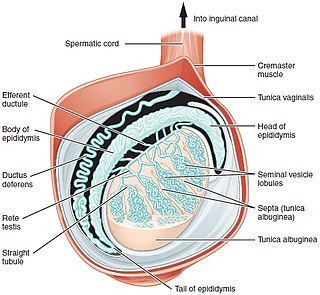 W
WTesticle or testis is the male reproductive gland or gonad in all animals, including humans. It is homologous to the female ovary. The functions of the testes are to produce both sperm and androgens, primarily testosterone. Testosterone release is controlled by the anterior pituitary luteinizing hormone; whereas sperm production is controlled both by the anterior pituitary follicle-stimulating hormone and gonadal testosterone.
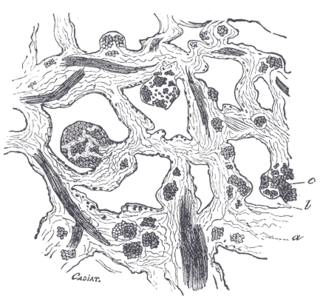 W
WFrom the internal surface of the fibrous envelope of the corpora cavernosa penis, as well as from the sides of the septum, numerous bands or cords are given off, which cross the interior of these corpora cavernosa in all directions, subdividing them into a number of separate compartments, and giving the entire structure a spongy appearance.
 W
WThe tubuli seminiferi recti are structures in the testicle connecting the convoluted region of the seminiferous tubules to the rete testis, although the tubuli recti have a different appearance distinguishing them from these two structures.
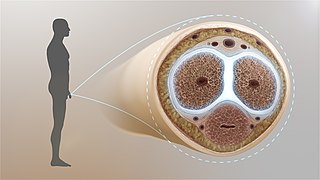 W
WThe tunica albuginea is the fibrous envelope that extends the length of the corpora cavernosa penis and corpus spongiosum penis. It is a bi-layered structure that includes an outer longitudinal layer and an inner circular layer. It consists of approximately 5% elastin, with the remainder mostly consisting of collagen.
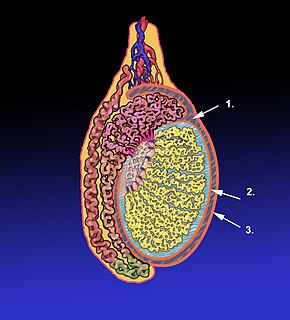 W
WThe tunica vaginalis is the pouch of serous membrane that covers the testes. It is derived from the vaginal process of the peritoneum, which in the fetus precedes the descent of the testes from the abdomen into the scrotum.
 W
WThe vas deferens, also called ductus deferens, is part of the male reproductive system of many vertebrates; these ducts transport sperm from the epididymis to the ejaculatory ducts in anticipation of ejaculation. It is a partially coiled tube which exits the abdominal cavity through the inguinal canal.